From the Toolbox: Personal Retrospectives

Each year since 2014, I retreat over the Christmas holidays and hold a personal retrospective. Over the course of two days, I reflect on the past year and make New Year’s resolutions1. In recent years, I have really surprised myself by how many I have been able to keep! Even if you only have a couple of hours to retreat, this is still a valuable exercise that I invite you to try for yourself. Christmas may be over but the good thing is, you can do this at any time!
My inspiration to do this came from a conversation I had at SoCraTes 2014. Martin Heider explained how he’s doing his yearly retrospective to me: He crafts his own apprenticeship diploma, reflecting on his past year from an imaginative mentor-perspective and offering advice to himself for the year to come.
Back then I was less fond of writing prose, so instead of writing a letter to myself, I covered my couch table in paper and started drawing a mind-map. Since then, I have improved the format every year. This year, when talking Christmas plans, people have become curious about my method. This is why I’m sharing it with you now. For obvious reasons, I won’t disclose the results of my personal retrospectives, though.
Context
I rarely take enough time to properly reflect on major events throughout the year, let alone appreciate or critically analyse them. Christmas holidays surprisingly happen to be the time of the year in Germany where the clocks seem to stand still. There are few distractions online, most of my peers are spending all of the holidays travelling or with their families2 and most importantly there are next to no social events to attend outside of your family circles. While I fully understand how loneliness can get to people during these days, I found that the retrospective doesn’t let it get to me during those days, as I enjoy doing it a lot.
Bear in mind that, even though I employ methods I learned in my professional career, I don’t want the goal of the retrospective to be to optimize my life, but to improve it. This framing changed a lot about how I look at the methodologies at work as well and I tend to think this is for the best.
Reasoning
My reason to hold these retrospectives is to look at the past year and focus not just on my achievements or the good things that happened, but plainly on the amplitudes, the up’s and down’s of the year and see where they have led me. From there, I want to carefully consider my wishes and aspirations for the future and see how I can achieve them.
Holding them for the last few years has helped me focus my efforts on aspects and challenges of my life, both private and professional, that previously seemed untameable.
Pattern
The retrospective is divided into three parts: the reflection, looking-forward and creating manageable resolutions. I tend to do one of them per day, with some time on the second day to reflect on the results from the reflection part. Creating manageable resolutions mostly involves gathering dry facts, sitting down and creating the resolutions so they’re tangible, reasonable and sincere.
The whole process involves a lot of drawing as I found it helps me being completely free to add notes and remarks whenever I see fit. I further found that writing everything by hand results in more careful wording, even though I’m not that used to handwriting any more. Get out that neglected fountain pen that’s been collecting dust in your drawer, it really helps!
Retrospective
I start the retrospective by putting myself into the right mindset. To get things going, I revisit noteworthy events by flicking through my calendar, making lists on the poster on my table as I go on. The purpose of this exercise is to focus myself on things that left a mark in my memory and to rediscover all the interactions and experiences I encountered this year:
- Places I’ve been to - Any place that I consider important goes onto that list, be it countries I’ve travelled to, friends I frequently visited that year or clubs that I enjoyed going to.
- People I’ve been with - Again, there’s no exact indicator that someone should go on the list; people I spent a lot of time working with, people I hadn’t seen in a long time or even people who bothered me throughout the year.
- Concerts I’ve been to and Music I’ve listened to throughout the year - This one is a rather specific one, but as I enjoy music and concerts a lot, I make sure to note these down as well as I associate a lot through music. Using Spotify has helped tremendously with this as they publish your personal Top 100 each year around Christmas.
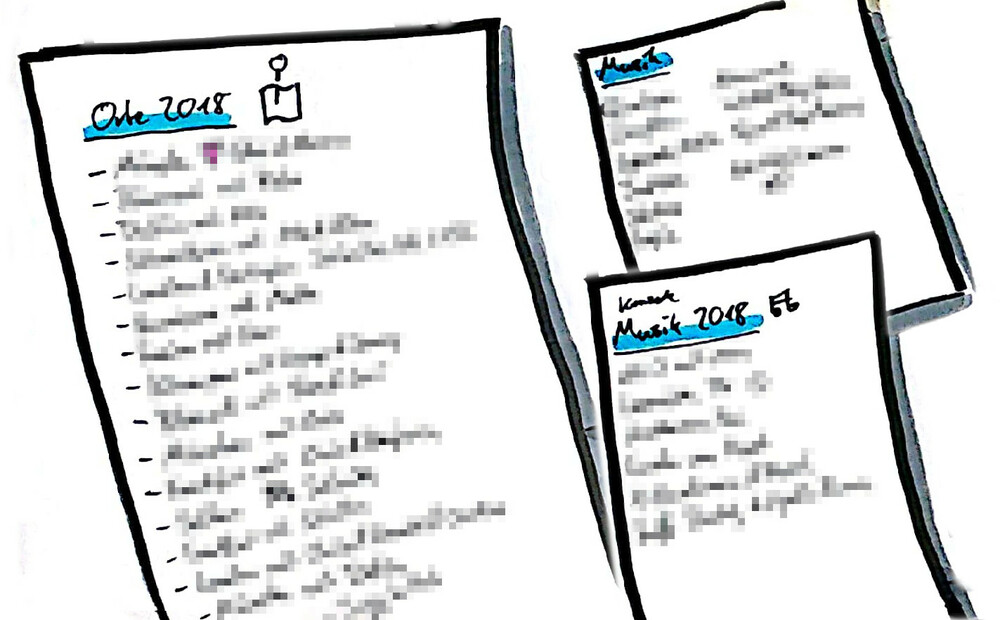
Going back to last year’s resolutions, I gather all the important personal goals - either because I successfully followed them through or because they fell under the table, even though I would’ve liked to follow through with them.
From here, I start writing down Three Words that come to my mind when reflecting on the year. Once the first three are written down, another three follow. I repeat this until I notice common themes around the words I’ve written down. For each theme, I note down why I suspect it came to my mind and how it shaped the year for me. As I write down my notes, I add the resolutions from last year (see below to learn how easy that is if you use a Personal Kanban board anyways) to the text as I see fit.
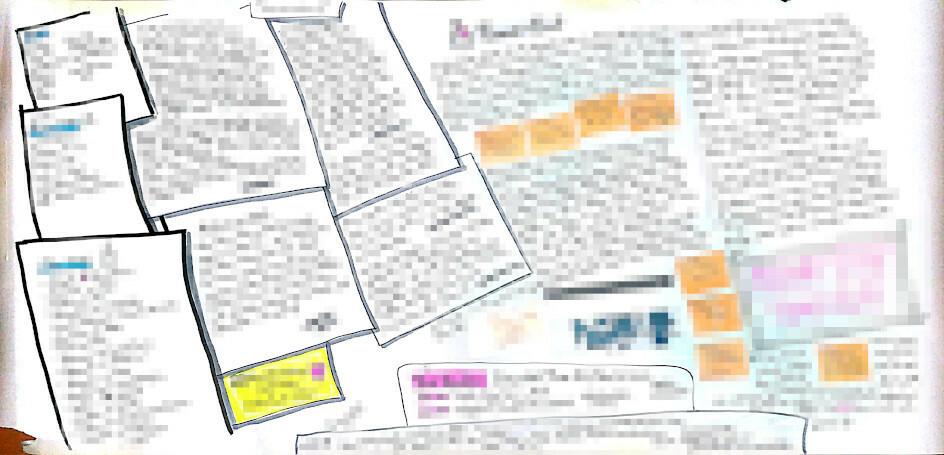
The resolutions that didn’t make it on the poster find their way to the notebook. Here, I revisit each one in turn and briefly note down whether I followed through and if so, how it went. If I didn’t complete them, I write down why I think I didn’t bother and decide whether I should have another crack this year.
The result of this is a notebook filled with appraisals of last year’s resolutions as you can see below (though pixelated).
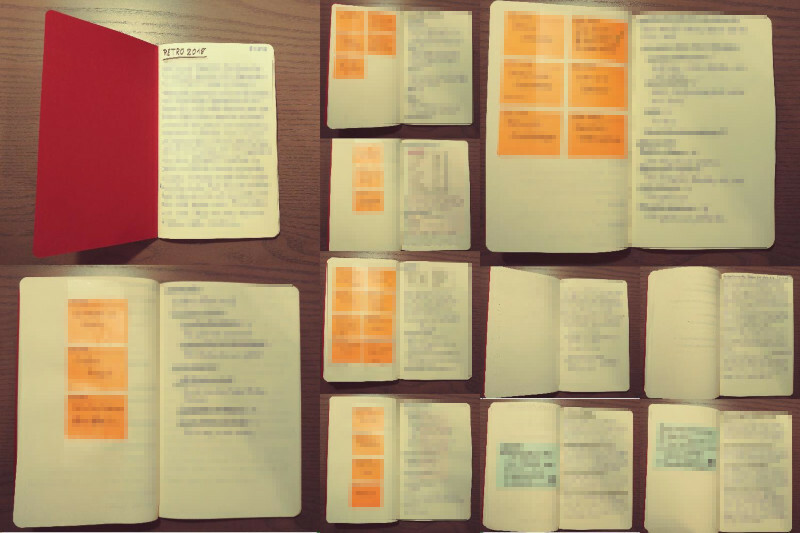
Again, the purpose of this exercise is to reflect, celebrate achievements (by myself, for once) and find out which of the unsuccessful resolutions remain important to me. This is prep-work for the Prospective and serves as a starting point to see which resolutions I’d like to make this year.
Prospective3
I start the Prospective part by creating a mind-map around two sentences:
I feel…, where I gather keywords around my personal mindset, my emotions and my mental health. Then, I wish…, where I start formulating things I’d like to improve in the next year.
While this mind-map can quickly start to feel overwhelming, remember that these things have been on your mind the whole time already. Only by writing them down do you get the chance to weigh your options and decide what you’d like to work on. You can really picture how they are intertwined, even sometimes around a central theme that you’ve been pushing away for quite some time.
Borrowing from the concept of OKRs4, I start creating Goals for myself. Each of these are a little ambitious in itself, just like how Toyota formulate their goals as True North Goals - ideal ways things should be. A constant reminder about them being next to unreachable is important, but in the true sense of the metaphor, it keeps your compass aligned to your True North.
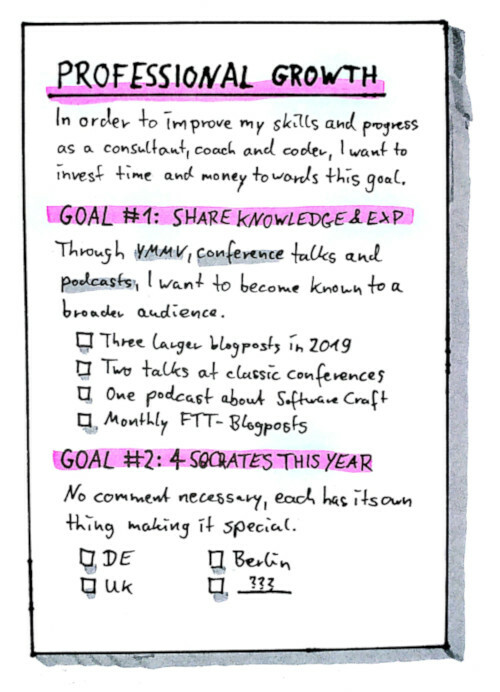
The result of this method is a little notebook full of Goals, why I want to achieve them and with some ideas for Resolutions on how I can move forward in achieving them.
Resolutions
The most important aspect of resolutions to me is that they should improve my life in the long run. They might vary in how ambitious they are and how much impact they have on my life, but once they’re formulated, I can work on them one at a time.
I have a natural WIP-limit (1) and only so much time at hand to work on them. This is why most of the time for this exercise is spent trying to break them down into chunks that I can work on in a matter of hours or days.
A personal example is my nicotine consumption: While I’ve never found the courage to quit, through my resolutions, I successfully switched to an electronic cigarette and I’ve been reducing my nicotine consumption carefully ever since - to a point where I personally still enjoy the ritual and am less concerned about my health, which has considerably improved over the last two years.5
This is the most tedious part, as the resolutions should contribute towards reaching the goal I set for myself, so a lot of care has to go into this. My (professional) instinct usually tells me to formulate the resolutions in a way that makes them measurable or trackable. But sometimes, in particular with deeply personal goals, a feeling or a perceptible change in life quality is more important than something quantifiable.
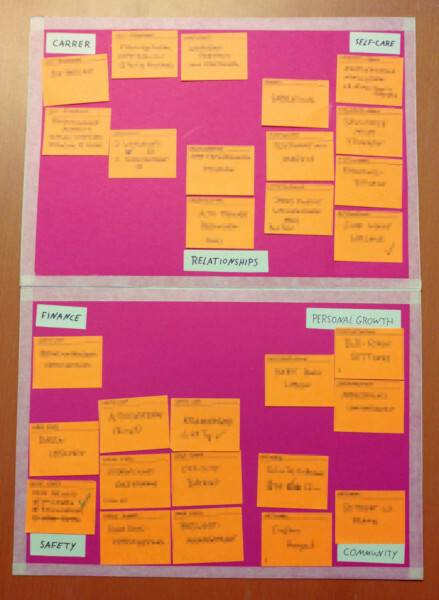
Last year I started putting these resolutions on two dedicated pages of my Personal Kanban Board as pictured above. This way, I always have them with me, can revisit them anytime and they can become part of my every-day workflow. As mentioned above, I further used the Post-It’s this year as I went through the list of last year’s resolutions to see which ones worked out and which ones didn’t.
For this year, I’ve planned to revisit the goals and results from this year’s retrospective every three months. I did this in order to shorten that feedback-loop and see if I can change priorities or even drop and add some resolutions from the list. Of course, this ritual is a resolution in itself that went on my Personal Kanban Board.
Over the last four years, I have found that each session went better than the previous one, with the method evolving and my outlook being more constructive than ever. So even if Christmas is already gone for the time being and you can only spare a few hours and - even better, if you don’t follow my format but come up with your own - I’m sure it’ll be a good exercise in self-actualization.
–
From the Toolbox is a compilation of small practices, tools and life-hacks I collected over the years.
-
As you’ll see later on, Christmas holidays happen to be the only time of the year where I can retreat without distractions. I wouldn’t mind doing a personal retrospective throughout the year, but it’s much easier to start during a time of few to no distractions and go from there. ↩
-
For the record, I do too, just not the whole time. ↩
-
I feel like I’m inventing a new word here 🤷 ↩
-
I’ve never seen them work, except for my own resolutions. Start small! ↩
-
Personal story, not medical advice, I’m not a professional, you know the drill. Oh and yes, I know about the dangers of electronic cigarettes. ↩